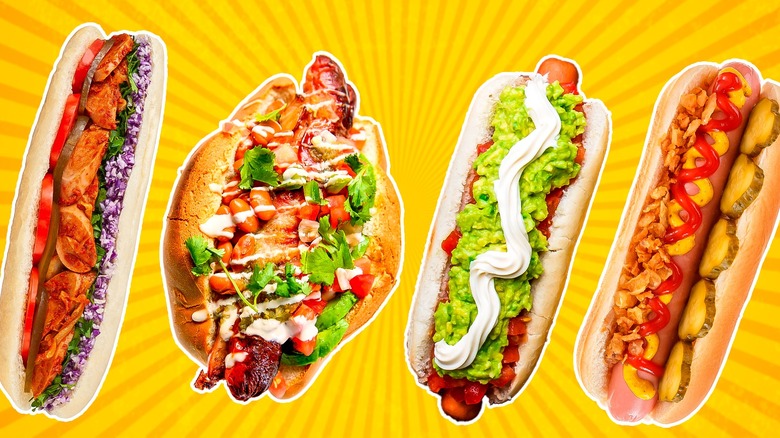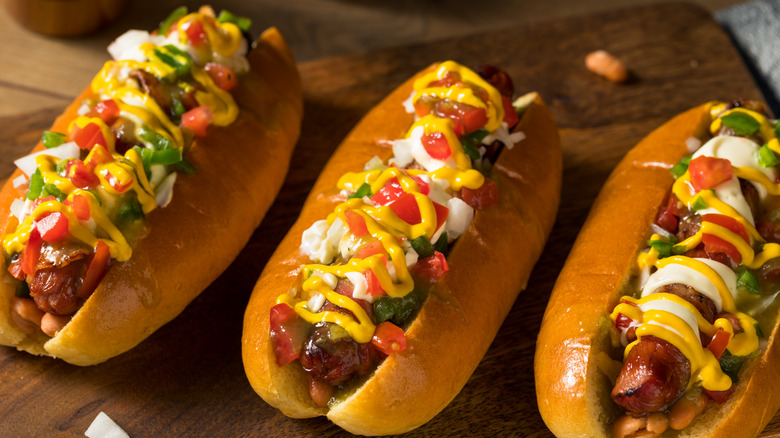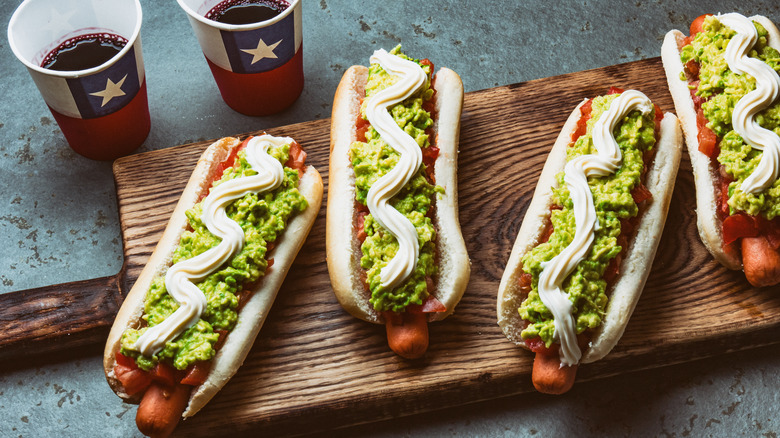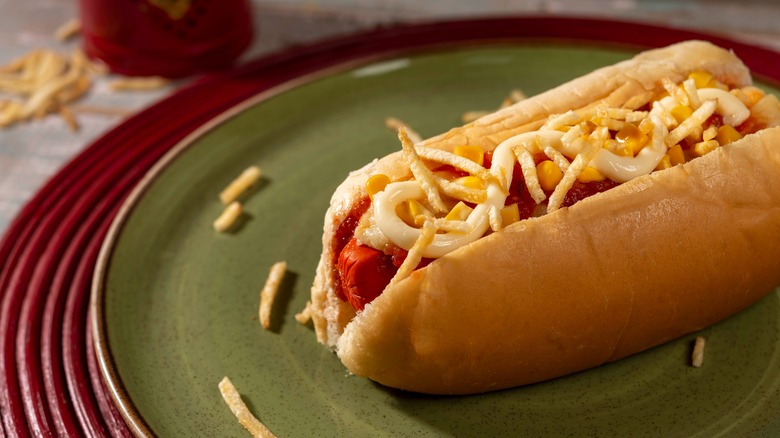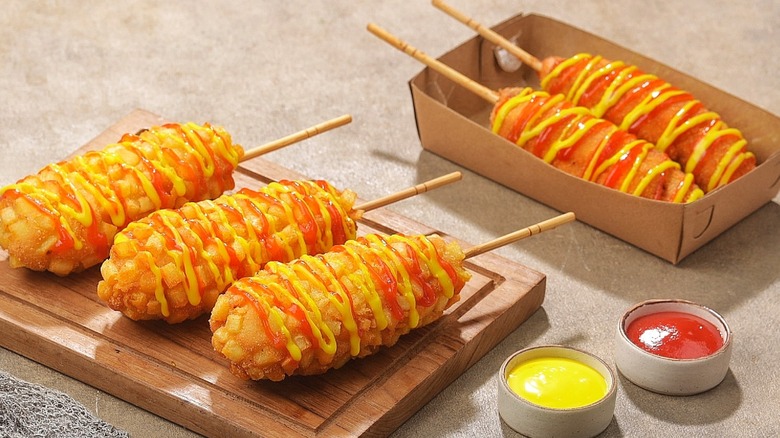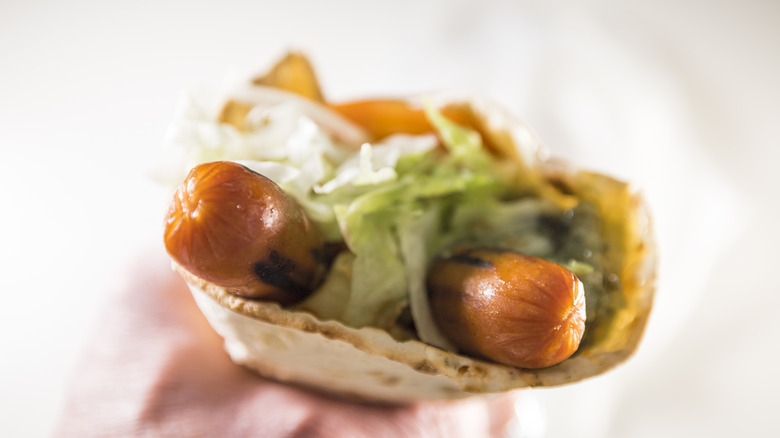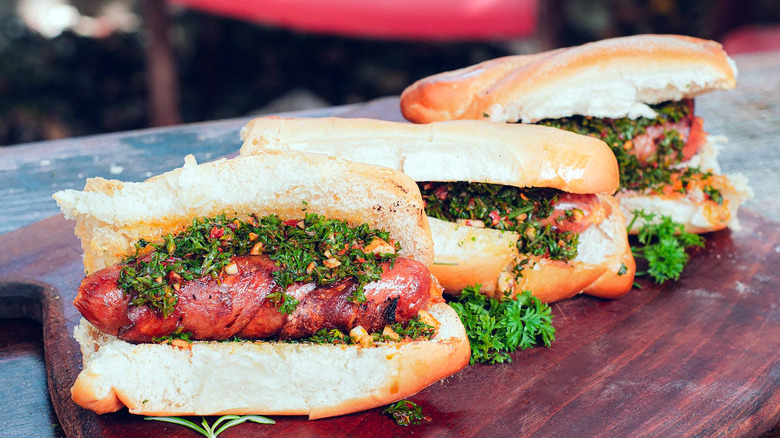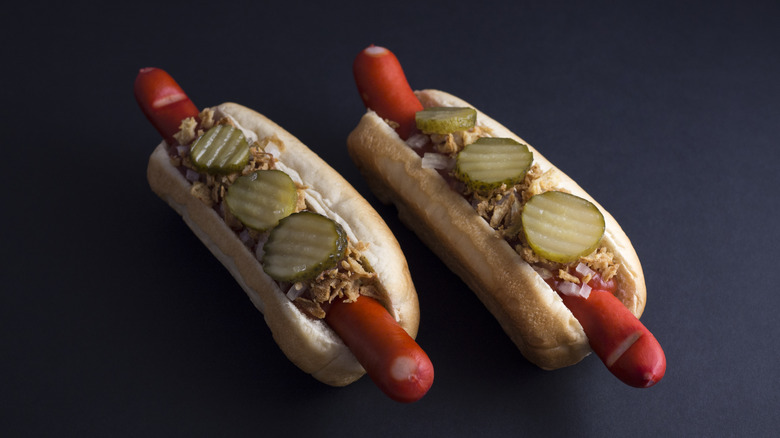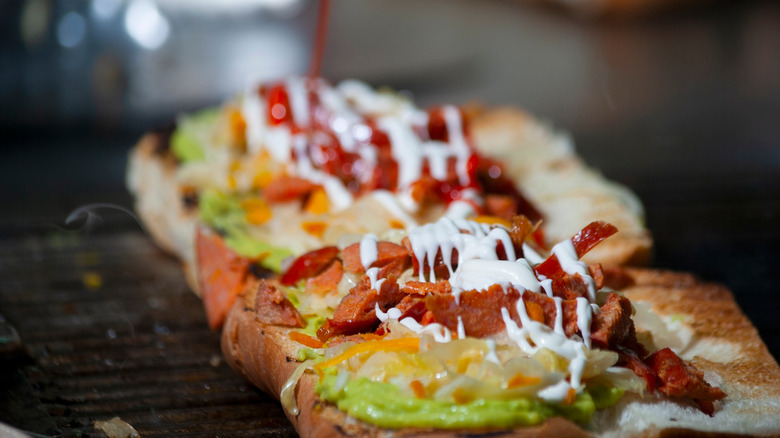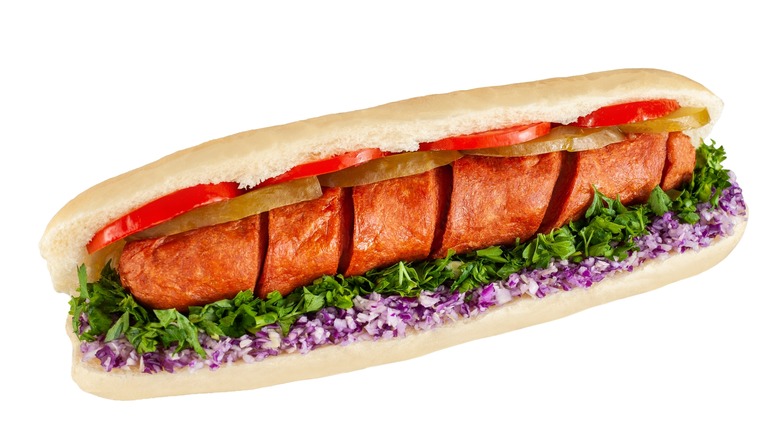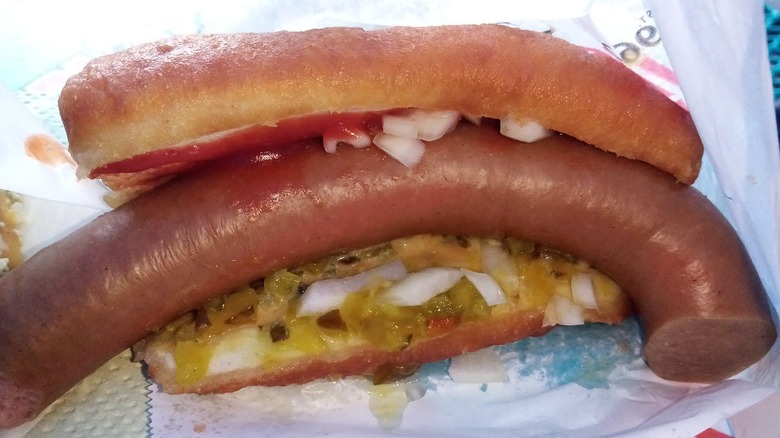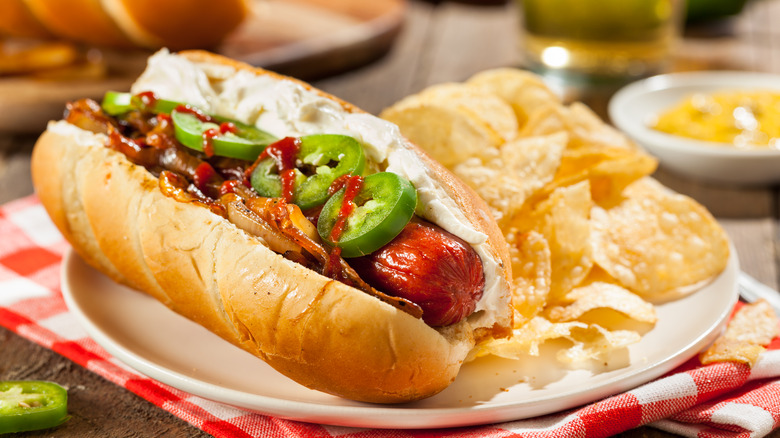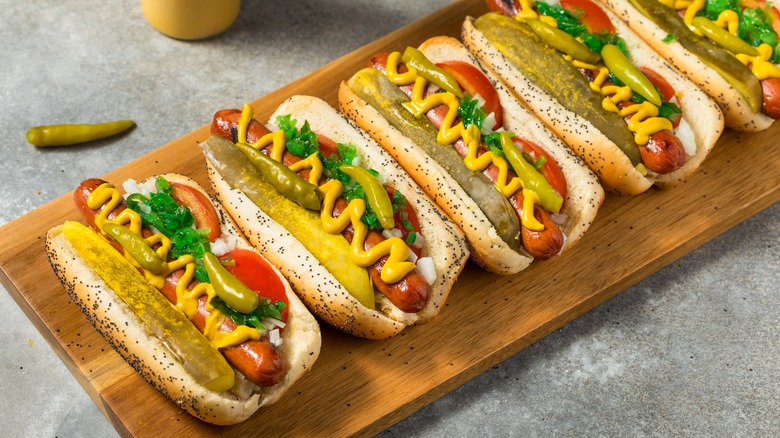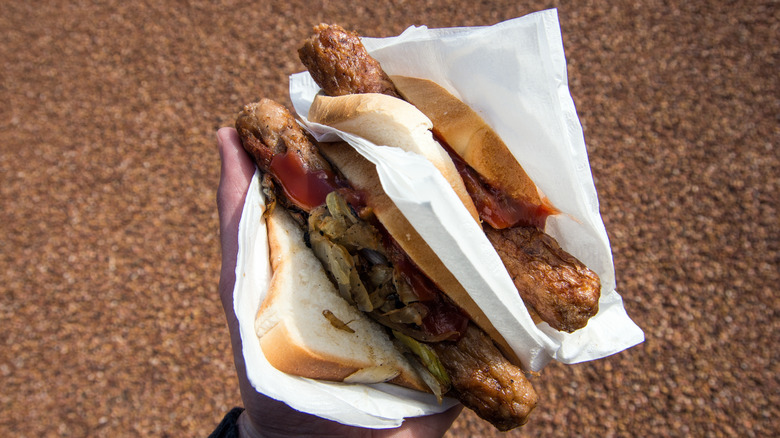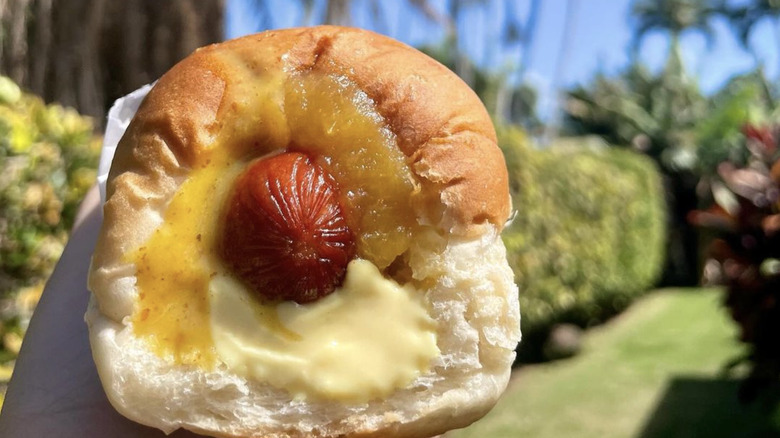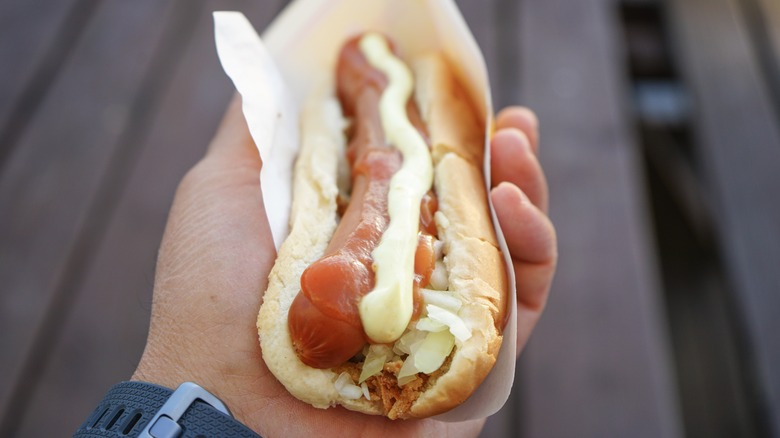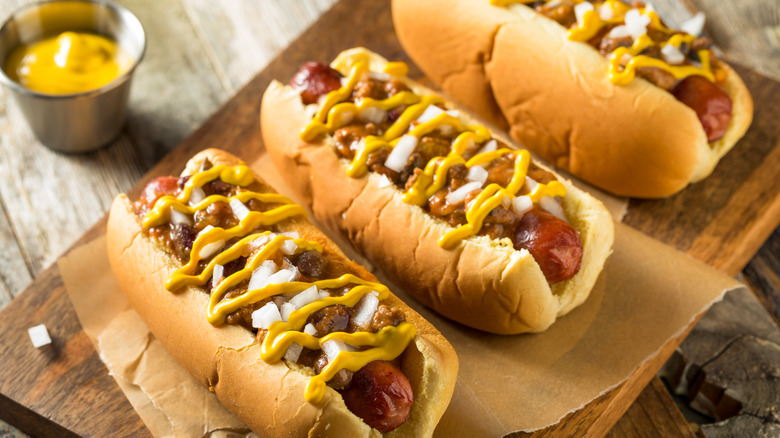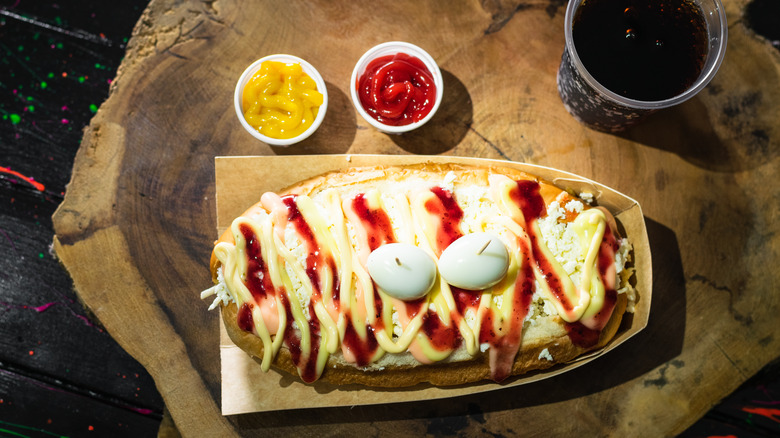20 Fascinating Hot Dog Variations From Around The World
Whether you're in a pinch, coming home from a late night out, or at a sports game and just crave a quick, cheap meal, a hot dog always comes to the rescue. In its most basic form, a sausage on a bun with ketchup or mustard always hits the spot. It is delicious in its simplicity.
However, it doesn't end there. A hot dog doesn't need to seal its fate as a one-trick pony. It has the essentials for greatness: bread, sausage, and toppings, all of which are incredibly versatile. Sausages can be made with different meat and spices. There are thousands of toppings to choose from, and bread can appear in a myriad of forms.
Around the globe, combinations of sausage, bread, and toppings have popped up, each shaped by deep-rooted culinary history and multi-cultural influence. From quail eggs in Colombia to cream cheese in Seattle to guacamole in Guatemala, the possibilities are endless, and they are out there for you to experience.
Sonoran - Mexico
A dish that gained popularity among students in the 1970s attending the University of Sonora in Hermosillo, Mexico, the Sonoran hot dog is a flavorful spin on an American classic. It consists of a hot dog wrapped in smokey bacon and adorned with a mountain of toppings like pinto beans, onions (both grilled and fresh), tomatoes, jalapeño salsa, and mayonnaise. Additional variations include crema, mustard, and chiles.
You'd think it's the bacon-wrapped sausage and topping combo that makes the Sonoran so popular, but the key to a perfect Sonoran hot dog is the bun. Rather than using a typical hot dog bun, these unique buns are soft, fluffy, and served up steamed rather than grilled. If you are in the U.S. and want to try this unique hot dog, you can find them at food trucks and restaurants all over the Valley in Arizona.
Completo - Chile
In the 1920s, hot dogs made their way to Chile from a businessman named Eduardo Bahamondes, who tried the dish in the U.S. and sought to introduce it to Chileans. During this process, Bahamondes hit a roadblock. The typical hot dog toppings of ketchup and mustard weren't appealing to the general public.
He switched gears, replacing the traditional condiments with avocado, diced tomato, mayonnaise, and salsa Americana. Sauerkraut and salsa verde are also common toppings. Completos gained popularity, and different variations developed. A lo pobre, or poor man's style, is a type of completo that features fried eggs, onions, and cheese. The chacarero opts for green beans, green chili peppers, tomatoes, and mayonnaise.
Cachorro quente - Brazil
The cachorro quente, which is Portuguese for "hot dog," is a Brazilian street food believed to have originated in the city of São Paulo. The cachorro quente is the perfect combination of textures and flavors, with juicy sausage, salty cheese, snappy peas, mayonnaise, and crunchy potato sticks. The buns are often lined with warm mashed potatoes. Other popular toppings included ground beef, corn, onions, and peppers.
The toppings are unique themselves, but what really sets a cachorro quente apart is the preparation of the sausages. The sausages are cooked in a tomato sauce with onions and seasoning, and sometimes the sauce becomes a topping itself. If you are looking for an authentic experience, try accompanying these hot dogs with the Brazilian spirit cachaça, which is featured in a classic caipirinha, the national drink of Brazil.
Gamja hot dog - South Korea
This trendy street food has made waves on social media sites like TikTok. The gamja hot dog, more popularly known in the States as the Korean corn dog, has been enjoyed in Korea since the 1980s, often sold by vendors at stalls on busy streets. These gamja hot dogs are the Rolls-Royce of corn dogs. Corn dogs are tasty on their own, but imagine one covered in crispy potato chunks, one filled with half cheese and half sausage, or adorned with a sprinkle of sugar.
Gamja hot dogs are truly a corn dog lover's dream. They are crunchy on the outside, soft and juicy on the inside, and salty and savory with a touch of sweetness. In 2016, with the help of social media, gamja hot dogs saw a surge in interest, with franchises capitalizing on the momentum. Nowadays, you can find gamja hot dogs at specialty grocery stores like H-Mart, both frozen and fresh.
Tunnbrödsrulle - Sweden
Whether you're a hot dog connoisseur seeking new variations, or on a quest to taste all of the dishes featured on Anthony Bourdain's show "No Reservations," look no further than the tunnbrödsrulle. Sweden's take on hot dogs, the tunnbrödsrulle is essentially a wrap, literally translating to "thin bread roll." Rather than the typical hot dog bun, Sweden opts for tunnbröd, a thin, grain flatbread.
The flatbread is then filled with mashed potatoes, commonly instant mash. The hot dogs follow. Ketchup and mustard can be added, along with toasted onions. The special ingredient that sets tunnbrödsrulle is the shrimp salad topping, also known as skagenröra. If you are not a big seafood fan, bostongurka, a Swedish pickle relish, is a popular alternative.
Choripán - Argentina
Choripán is a story of culinary fusion stemming from European immigrants in Argentina in the 19th century. The Argentine chorizo sausage has Italian and Spanish influences using pork but with a robust spice level and flavor profile. The choripán, which uses chorizo, garnered popularity among locals after being served at football matches, and now it can be found on street corners, stalls, and events across Argentina.
A traditional choripán includes a toasted French baguette rather than a bun. The chorizo is grilled, sliced down the middle, and filled with fresh chimichurri, an oil-based sauce with herbs like cilantro and parsley. Now a staple dish in Argentine cuisine, it is estimated that hundreds of millions of choripánes are sold each year.
Danish hot dogs - Denmark
Street hot dogs have an illustrious history in Copenhagen. The first vendors appeared in the 1920s and gained popularity in the 1930s. In order to be considered self-employed, vendors had to prove to the government that they were either disabled or unable to work another job, which made hot dog vending personal, with many vendors naming their stands after themselves.
You can still see uniquely named stalls in Denmark today. After World War II, hundreds of stands popped up around Denmark, offering a variety of different toppings. One of the classic variations includes curried rémoulade, pickled cucumbers, fresh and fried onions, and the classics, ketchup and mustard.
Steamies and toasties - Canada
When it comes to Canadian hot dogs, Montreal knows what its doing. Montreal street food hosts two styles of hot dogs, each with its own fanbase: the steamie, or "steamés" in French, and the toastie, or "toasté." The difference between the two styles is that with the steamie, a steamed hot dog is accompanied by a steamed bun.
The toastie opts for a grilled hot dog with a toasted bun. Some places brush the buns with butter before toasting for extra flavor and crispiness. The real key to each of these dogs is to order them "all dressed." This includes chopped onions, mustard, relish, and a cabbage slaw. If you're ever in Montreal, give both the steamie and the toastie a try, and decide for yourself which one reigns supreme.
Pølse - Norway
The pølse, or hot dog, is Norway's national snack. On Norway's national day, May 17th, over 10 million sausages are typically consumed. In a single year, Norwegians eat around 500 million sausages. It is ingrained in their culinary culture, stemming all the way back to the Vikings.
Hot dogs spiked in popularity in the 1950s and different regional variations took hold. One of which is a sausage made using reindeer meat. Another common way to eat hot dogs in Norway, which poses similarities to Sweden, is wrapping sausage in a flatbread called lompe, a type of potato tortilla. Potato salad or shrimp salad are common toppings as well.
Shuco - Guatemala
Shucos are Guatemalan-style hot dogs that can be found at restaurants and eateries throughout the country. Shuco is Guatemalan slang for "dirty," but don't let that veer you away. This hot dog variation is smokey, fresh, and addicting. The first step to a good shuco is grilling the hot dog and buns.
The dish isn't limited to traditional hot dogs. A variety of sausages can be used. Once cooked, the sausages should be cut up into bite-sized pieces. The key that makes shuco unique is lathering the bun with fresh guacamole. Cabbage slaw, onions, and peppers are common toppings, along with ketchup, mustard, and mayonnaise. Other popular toppings include queso, chimichurri, and pico de gallo.
Sosis bandari - Iran
Originating in the Southern provinces and port cities of Iran, sosis bandari translates to "port sausage" and is a popular street food sandwich throughout the country. Both fragrant and colorful, the dish is a culmination of years of trading and cultural influences.
The dish became popular amongst students as an affordable and filling meal. Beef frankfurters, cut into chunks, are tossed together with cooked and diced potatoes. Onions and peppers are sauteed in tomato paste and spices like turmeric and cayenne. Some recipes use curry powder or cumin as well. The ingredients are assembled onto a bread roll with tomato slices. Common additions include lettuce, parsley, and pickles. Mayonnaise and mustard can also be added. The final result is spicy, salty, and warming.
Kuuma koira - Finland
A staple to Finland's street food scene, kuuma koira can be found at music festivals, on street corners, and in markets around Finland. Literally translating to "hot dog," kuuma koira uses high-quality sausages that vary from beef to pork to reindeer. The sausages, rather than served in a typical bun, are served in sugar-dusted donuts that are shaped like rectangles.
The sausages are then topped with mustard, ketchup, chopped onions, and relish. This sweet, salty, and sour combination is an explosion of flavor. The hot dog is usually served wrapped in paper, and locals often scarf it down with milk, beer, or Finnish soda.
Seattle dog - USA
Seattle, the Emerald City, the birthplace of grunge, is also the home to the mouthwatering Seattle dog. If you haven't tried a Seattle dog yet, you're missing out. Invented by a bagel salesman in Pioneer Square in the 1980s who served sausage with bagel sticks and cream cheese, the hot dog has since taken on a life of its own.
The classic Seattle staple starts with a traditional hot dog and bun but veers into new territory by lathering cream cheese on the interior. The sausage is typically sliced in half and topped with grilled onions, peppers, and sauerkraut. Thinly sliced jalapeños add a pop of spice and color, but if you want an extra kick, Sriracha and mustard are common additions. The Seattle dog is such a staple in Seattle that it can be found at Lumen Field and T-Mobile Park, the home fields of Seattle's football and baseball teams.
Chicago dog - USA
Perhaps one of the best-known hot dogs in America, the Chicago dog rivals New York's dirty water dog as the quintessential hot dog. The famed Chicago dog consists of an all-beef hotdog with yellow mustard, green pickle relish, a pickle spear, tomato wedges, and pickled peppers. It's all stacked in a poppy seed roll with a dash of celery salt.
The Chicago dog is more than a casual snack; it is a force to be reckoned with. Chicagoland is proud of its hot dogs with the Chicago area rumored to have more hot dog restaurants than fast food burger joints. Vienna Beef, the Chicago-based manufacturer of the beef hot dogs primarily used in the Chicago dog, advertised during the Great Depression that its dogs came with a salad on top.
Sausage sizzle - Australia
In true Aussie fashion, it isn't an election day without a sausage sizzle. A sausage sizzle is an event that serves up sausage sandwiches. The events are typically associated with charities or local community fundraisers, where sausages are served on white sandwich bread with onions and tomato sauce. Barbecue sauce and mustard are also common toppings.
On election day specifically, the dish is called the "democracy sausage," and it is a national tradition to have one. There are ongoing debates regarding the best way to eat this sandwich, and politicians have been criticized for their eating style and topping choices. This event and dish are thoroughly ingrained in Australia's history. They have always been affordable ways to bring the community together, comparable to a barbecue in the U.S.
Puka dog - USA
As seen on Anthony Bourdain's show "No Reservations," the puka dog is a Hawaiian-style hot dog that is a staple to the island of Kauai. Served up locally at the restaurant Puka Dog, the hot dog has a fruity island twist that pairs well with the salty, savory sausage. The restaurant bakes its own buns, toasting a hole in the middle for the hot dog to slide into.
They use a secret garlic lemon sauce that comes in a variety of different spice levels. There are relish options as well, made with tropical fruit like banana, mango, or coconut. To finish it all off, the hot dog is topped with passion fruit mustard. The restaurant recommends pairing the puka dog with refreshing homemade lemonade.
Pylsa - Iceland
Iceland is notorious for unique dishes like fermented shark or sheep's head, but if you aren't quite as adventurous but still want to taste a unique dish, go for pylsa. Pysla, or the Icelandic hot dog, is more than just a cheap street food snack. Made with locally sourced, high-quality ingredients, the pylsa is a must-try. The sausages are typically filled with local lamb or sheep meat, along with pork and beef.
The natural casings give the boiled sausage that classic snap, and steamed buns provide a pillowy base. Ketchup and onions, both fried and raw, are popular toppings, but the stars are remoulade and Icelandic mustard. The mustard, also known as pylsusinnep, is brown in color and has a mild sweetness and spiciness that pair well with the lamb in the sausages. If you find yourself in Iceland, grab a bottle of pylsusinnep to bring home.
Coney dog - USA
Coney Island is synonymous with Nathan's Hot Dogs, as the famous proprietor hosts the Fourth of July hot dog eating contest on Coney Island every year. With Coney Island meaning hot dog in the mind of most Americans, restaurateurs in the Midwest took to naming their hot dogs "Coney dogs." Detroit is the location of two of the most famous restaurants serving Coney dogs; Lafayette Coney Island and American Coney Island.
The rival restaurants claim to both be the first serving the Coney dog. This hot dog is typically topped with chili, onions, and condiments. However, this version of the hot dog can be found all over the Midwest with slight alterations on the chili meat sauce adorning the hot dog.
Perro caliente colombiano - Colombia
If you're a fan of loaded hot dogs, perro caliente Colombiano is a must-try. At first glance, this Colombian-style hot dog seems like it wouldn't work. There's tangy, sweet pineapple sauce, garlic mayonnaise, and salsa rosada. There are crumbled-up potato chips hiding a boiled hot dog beneath it. There are even multiple quail eggs, hardboiled and placed whole at the very top.
It doesn't end there. Many street vendors offer a plethora of other sauces, too, like barbecue or avocado sauce. The combination itself seems obscure, but somehow, it works, and it works well. If you ever find yourself in Colombia, keep an eye out for street vendors, and if you order a hot dog, make sure not to skimp on the toppings.
New York dirty water dog - USA
The classic yellow and blue Sabrett's umbrella over a food cart means only one thing — a traditional New York dirty water dog. Coined dirty water after the seasoned water vats that boil the hot dogs, the broth often contains ketchup, chili powder, cumin, and other spices to enhance the hot dogs' flavor. Pulled out steaming hot onto a plain bun, it's served with ketchup, mustard, chopped white onions, and sauerkraut.
This simple yet classic dog often is the first thing that comes to mind when thinking of the humble hot dog. If you find your way to New York City, you'll inevitably come across a hot dog stand ... or a few dozen. They are on nearly every street corner, and for good reason. Not only are these hot dogs an affordable, quick bite, they are absolutely delicious.
